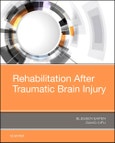- Covers neuroimaging, neurosurgical and critical care management, management of associated complications after TBI, pharmacotherapy, pain management, sports concussion, assistive technologies, and preparing patients for community reintegration.
- Discusses special populations, including pediatric, geriatric, and military and veteran patients.
- Consolidates today's available information and guidance in this challenging and diverse area into one convenient resource.
Please Note: This is an On Demand product, delivery may take up to 11 working days after payment has been received.
Table of Contents
Rehabilitation After Traumatic Brain Injury, 1e- Acute Management of TBI (Editor Note: Neurosurgical & Critical Care Management)
- Defintion, Severity Classifcation, Epi, and Pathophys Levels of Rehab Care (Editor Note: including IDT, MDT)
- Management of Complications after TBI (Editor Note: Spasticity, DVT, Autonomic Dysfunction, Neuroendocrine, HO,GI Nutriotional issues)
- Neurological Disorders (Editor Note: including Hydrocephalus, Post traumatic Seizures, Cranial N d/o, Movement Disorders, Neurosensory Changes)
- Assessment and Management of Military & Veteran TBI
- Assessment and Management of Sports Concussion
- Neuropsychiatric Sequale (Editor Note: including Post-Traumatic Agitation)
- Pharmacotherapy in Rehabilitation of TBI
- Post Traumatic Pain Management
- Neuroimaging
- Disorders of Consciousness
- Cognitive Rehabilitation (Editor Note: through the continuum of care)
- Prognosis, Outcome Measures, and Prevention
- Pediatric TBI
- Geriatric TBI
- Neuroprosthetics (Editor Note: including Assistive Technology, Augmentative Communication Device, Mobility)
- Chronic Traumatic Encephalopathy
- Anoxic Brain Injury
- Community Reintegration (Editor Note: including Educational,Vocational,Driving)








